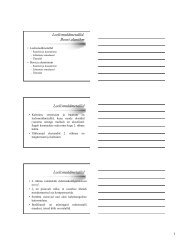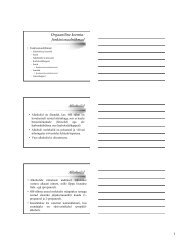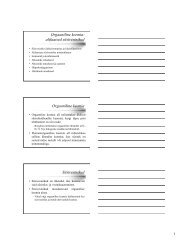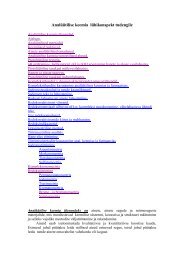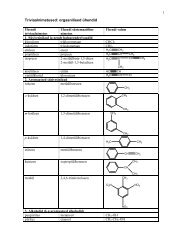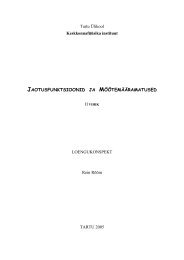ESI-LC-MS Matrix Effect Toolbox
ESI-LC-MS Matrix Effect Toolbox
ESI-LC-MS Matrix Effect Toolbox
Create successful ePaper yourself
Turn your PDF publications into a flip-book with our unique Google optimized e-Paper software.
Comparison of different methods aiming to account for/overcome matrix<br />
effects in <strong>LC</strong>/<strong>ESI</strong>/<strong>MS</strong> on the example of pesticide analyses<br />
Anneli Kruve, Ivo Leito Analytical Methods 2013, 5, 3035-3044<br />
http://dx.doi.org/10.1039/C3AY26551J<br />
<br />
<br />
<br />
Anneli Kruve
Electrospray ionization<br />
• <strong>ESI</strong> is used to connect<br />
<strong>LC</strong> and <strong>MS</strong><br />
• <strong>LC</strong> effluent is sprayed<br />
into small droplets<br />
• Droplets devide into<br />
smaller droplets<br />
• From the surface of<br />
small droplets ions can<br />
reach gas phase<br />
Nebulizer gas N 2<br />
+<br />
+<br />
+<br />
HP<strong>LC</strong> effluent<br />
Nebulizer<br />
+<br />
+<br />
+ + + + + + + + +<br />
Voltage ~3500 V<br />
+<br />
<strong>MS</strong><br />
Drying gas N 2<br />
Waste<br />
2
Contents<br />
• <strong>Matrix</strong> effects in <strong>LC</strong>-<strong>ESI</strong>-<strong>MS</strong>, their<br />
presence and evaluation<br />
• Approaches for combating matrix effects<br />
– Extrapolative dilution<br />
– Sample preparation<br />
– Accounting for matrix effects<br />
– <strong>ESI</strong> optimization to reduce matrix effects<br />
• Conclusions<br />
3
<strong>Matrix</strong> effect<br />
• Ionization efficiency in <strong>ESI</strong> depends on:<br />
– Solvent composition<br />
– <strong>ESI</strong> parameters<br />
– Compounds<br />
co-eluting with<br />
analyte<br />
Are not present<br />
in standards but<br />
are present in<br />
samples<br />
Are kept constant<br />
during analyses<br />
Same amount of<br />
analyte gives<br />
different signal<br />
in sample and in<br />
standard<br />
<strong>Matrix</strong> effect<br />
4
How does matrix effect look like?<br />
Intens.<br />
x10 5<br />
Analyte in standard<br />
4<br />
3<br />
2<br />
Analyte in sample<br />
1<br />
0<br />
12.0 12.5 13.0 13.5 14.0 14.5 15.0 Time [min]<br />
5
Combating matrix effect<br />
• Reducing matrix effects<br />
– Sample preparation<br />
– Dilution of the sample<br />
– Instrumental parameters<br />
• Taking matrix effect into account<br />
– Correcting results<br />
– Uncertainty<br />
6
Evaluation of matrix effect<br />
• Is expressed as a ratio of analyte signal in sample and in<br />
standard: %ME<br />
PeakArea<br />
% ME =<br />
Sample<br />
⋅100%<br />
PeakArea S tandard<br />
CalibrationGraphSlope<br />
% ME =<br />
CalibrationGraphSlope<br />
Sample<br />
Standard<br />
⋅100%<br />
• %ME 100% - no matrix effect<br />
• %ME100% - ionization enhancement<br />
7
Glyphosate calibration graph in<br />
cereals<br />
Slopes vs Peak Areas<br />
1.60E+07<br />
1.40E+07<br />
Standard<br />
Wheat<br />
Rye<br />
In case of wheat calibration<br />
graph becomes nonlinear -<br />
%ME is not constant<br />
1.20E+07<br />
In case of strong supression<br />
1.00E+07<br />
calibratin graph is linear<br />
Peak area<br />
8.00E+06<br />
6.00E+06<br />
4.00E+06<br />
2.00E+06<br />
0.00E+00<br />
0.0 2.0 4.0 6.0 8.0 10.0 12.0 14.0 16.0<br />
c (mg/kg)<br />
8
<strong>Matrix</strong> effect’s dependence on<br />
analyte concentration<br />
Garlic sample<br />
Aldicarb<br />
Methomyl<br />
Thiabendazole<br />
0 1 2 3 4 5<br />
c, mg/kg<br />
160%<br />
140%<br />
120%<br />
100%<br />
80%<br />
60%<br />
40%<br />
20%<br />
0%<br />
% M E<br />
• %ME depends on the<br />
analyte concentration<br />
in the sample<br />
• Risk of<br />
underestimated results<br />
at lower<br />
concentrations<br />
• %ME can not be used<br />
for correction of the<br />
analysis results<br />
9
Sample dilution<br />
%ME<br />
120%<br />
100%<br />
80%<br />
60%<br />
40%<br />
20%<br />
0%<br />
0.00 0.20 0.40 0.60 0.80 1.00 1.20<br />
Dilution factor<br />
• The amount of<br />
co-eluting compounds<br />
is reduced<br />
• <strong>Matrix</strong> effect is<br />
reduced<br />
• <strong>Matrix</strong> effect may or<br />
may not be eliminated<br />
10
Calculated concentration (mg/kg)<br />
0.60<br />
6.00<br />
0.50<br />
0.45<br />
0.50<br />
A 5.00<br />
B<br />
0.40<br />
C<br />
0.40<br />
4.00<br />
0.35<br />
0.30<br />
0.30<br />
3.00<br />
0.25<br />
0.20<br />
0.20<br />
2.00<br />
0.15<br />
0.10<br />
0.10<br />
1.00<br />
0.05<br />
0.00<br />
0.00<br />
0.00<br />
0 0.2 0.4 0.6 0.8 1 1.2<br />
0 0.05 0.1 0.15 0.2 0.25 0.3<br />
0 0.2 0.4 0.6 0.8 1 1.2<br />
Calculated concentration (mg/kg)<br />
Dilution factor<br />
Dilution factor<br />
Dilution factor<br />
Calculated concentration (mg/kg)<br />
No matrix effect<br />
Dilution eliminates<br />
matrix effect<br />
Dilution does not<br />
eliminate matrix effect<br />
Analyte concentration is<br />
calculated as the average<br />
of all the measurements<br />
Analyte concentration is<br />
the average of 3 most<br />
diluted samples<br />
Analyte concentration is<br />
estimated as the<br />
intercept of the plot<br />
11
Validation<br />
• 5 fruits and vegetables, spiked with 5<br />
pesticides at 2 concentration levels<br />
– 11 observations of situation A<br />
– 6 observations of situation B<br />
– 33 observations of situation C<br />
• According to E n scores all of the calculated<br />
concentrations agreed with the spiked<br />
concentrations<br />
12
Sample preparation<br />
180%<br />
160%<br />
140%<br />
120%<br />
100%<br />
80%<br />
60%<br />
40%<br />
20%<br />
0%<br />
Luke QuEChERS <strong>MS</strong>PD<br />
14<br />
aldicarb sulphoxide<br />
aldicarb sulphone<br />
demeton-S-methyl sulphoxide<br />
carbendazim<br />
methomyl<br />
thiabendazole<br />
methiocarb sulphoxide<br />
methiocarb sulphone<br />
aldicarb<br />
imazalil<br />
phorate sulphoxide<br />
phorate sulphone<br />
methiocarb<br />
Luke and <strong>MS</strong>PD result in less matrix effect
Thiodicarb<br />
• In all samples<br />
ionization<br />
enhancement was<br />
observed<br />
• Enhancement occured<br />
with all sample<br />
preparation methods<br />
Valge klaar (Rakvere)<br />
Blank solvent<br />
700%<br />
600%<br />
500%<br />
400%<br />
300%<br />
200%<br />
100%<br />
0%<br />
15<br />
Valge klaar (Tartu)<br />
Tellissaare<br />
Melba (Rakvere)<br />
Antonovka (Tartu)<br />
Kuldrenett (Tartu)<br />
Kuldrenett (Rakvere)<br />
Talvenauding<br />
Suislepp<br />
Pikniku<br />
%ME
“Seeing” matrix effect<br />
UV absorbance, mAU<br />
18<br />
16<br />
14<br />
12<br />
10<br />
8<br />
6<br />
Interfring<br />
compound<br />
Minimum in aldicarb<br />
peak in case of<br />
QuEChERS extract<br />
6000000<br />
5000000<br />
4000000<br />
3000000<br />
2000000<br />
<strong>MS</strong> signal, cps<br />
• Next to aldicarb a<br />
peak elutes in the UVchromatogram<br />
• The shape of aldicarb<br />
peak is distorted<br />
4<br />
1000000<br />
2<br />
0<br />
12.3 12.8 13.3 13.8 14.3<br />
0<br />
Retention time, min<br />
16
Correlation between the UV peak<br />
and matrix effect<br />
U V pe a k a re a<br />
450000<br />
400000<br />
350000<br />
300000<br />
250000<br />
200000<br />
150000<br />
• Measurements are<br />
carried out at different<br />
analyte<br />
concentrations!<br />
100000<br />
50000<br />
0<br />
0% 10% 20% 30% 40% 50% 60% 70% 80% 90% 100%<br />
%ME<br />
17
Hypothesis<br />
• If for aldicarb a compound causing matrix<br />
effect can be seen in UV, then for other<br />
analytes such compounds may exist also<br />
– Scanned mass spectra<br />
• Background ions<br />
19
Background ions<br />
• Are always there<br />
– Solvent impurities<br />
– Plasticizers<br />
• Originate from the sample<br />
– Co-extracted compounds<br />
Intensity changes<br />
due to matrix effect<br />
May cause matrix<br />
effect<br />
20
Scanned Spectra<br />
Garlic samples<br />
Standards<br />
Onion samples<br />
• PCA was used to<br />
select background ions<br />
varying most from<br />
standards to samples<br />
21
Correction of analysis results<br />
Average error (mg/kg)<br />
Average error (mg/kg)<br />
0.60<br />
0.50<br />
0.40<br />
0.30<br />
0.20<br />
0.10<br />
0.00<br />
0.70<br />
0.60<br />
0.50<br />
0.40<br />
0.30<br />
0.20<br />
0.10<br />
0.00<br />
Methomyl<br />
Carbendazime<br />
Thiabendazole<br />
Aldicarb<br />
Imazalil<br />
Methiocarb<br />
Training set<br />
n=1 n=2 n=3 n=4 n=5 n=6<br />
Number of linear combinations<br />
Test set<br />
n=1 n=2 n=3 n=4 n=5 n=6<br />
Number of linear combinations<br />
Methomyl<br />
Carbendazime<br />
Thiabendazole<br />
Aldicarb<br />
Imazalil<br />
Methiocarb<br />
• Background ions<br />
intensities together<br />
with analyte peak area<br />
were used in PLS<br />
regression to calculate<br />
the analyte<br />
concentration<br />
22
Results<br />
Average error<br />
Garlic Onion Garlic Garlic Standard Standard Solvent (mg/kg)<br />
Methomyl Spiked 0.89 0.87 0.48 0.89 1.49 0.90 0.00<br />
PLS 0.74 1.02 0.56 0.90 1.46 0.88 -0.13 0.10<br />
Solvent calibration 0.74 1.01 0.38 0.74 1.42 0.87 -0.07 0.11<br />
Carbendazim Spiked 0.25 0.25 0.14 0.25 0.42 0.25 0.00<br />
PLS 0.17 0.23 0.15 0.20 0.44 0.34 -0.02 0.05<br />
Solvent calibration 0.14 0.21 0.07 0.12 0.38 0.28 -0.02 0.07<br />
Thiabendazole Spiked 1.14 1.11 0.61 1.14 1.91 1.14 0.00<br />
PLS 0.84 1.07 0.92 0.78 2.14 1.41 -0.14 0.25<br />
Solvent calibration 0.65 0.90 0.30 0.38 1.74 1.18 -0.09 0.38<br />
Aldicarb Spiked 0.92 0.90 0.50 0.92 1.54 0.92 0.00<br />
PLS 1.20 0.85 0.78 0.55 1.34 1.00 0.05 0.22<br />
Solvent calibration 0.25 0.58 0.06 0.22 1.37 0.97 -0.11 0.43<br />
Imazalil Spiked 1.13 1.11 0.61 1.13 1.89 1.13 0.00<br />
PLS 1.25 0.83 1.19 0.91 1.89 1.29 0.09 0.27<br />
Solvent calibration 0.32 0.60 0.19 0.38 1.78 1.12 -0.20 0.49<br />
Methiocarb Spiked 0.99 0.97 0.54 0.99 1.66 1.00 0.00<br />
PLS 0.88 1.09 0.86 0.60 1.31 0.95 -0.01 0.24<br />
Solvent calibration -0.10 0.28 -0.11 -0.10 1.47 1.01 -0.12 0.69<br />
23
<strong>Matrix</strong> effect as an uncertainty<br />
source<br />
• If low uncertainty is not needed in the analysis<br />
then matrix effect can be included as an<br />
uncertainty source<br />
• <strong>Matrix</strong> effect graph approach<br />
• <strong>Matrix</strong>-matched calibration<br />
25
<strong>Matrix</strong> effect graph<br />
• Each calibration solution is prepared in a different<br />
matrix<br />
– Same commodity group<br />
– Different commodity groups<br />
26
Single-matrix<br />
calibration<br />
A<br />
i<br />
ε<br />
r<br />
i<br />
= b0 + b1<br />
⋅Ci<br />
+ ε<br />
i<br />
=<br />
b<br />
0<br />
ε<br />
i<br />
+ b<br />
1<br />
⋅C<br />
i<br />
Same commoditygroup<br />
calibration<br />
realtive unsigned residuals<br />
1.200<br />
1.000<br />
0.800<br />
0.600<br />
0.400<br />
0.200<br />
<strong>Matrix</strong> effect graph for Methiocarb<br />
eggplant<br />
beans<br />
garlic<br />
apple<br />
lemon<br />
rye<br />
gooseberries<br />
0.000<br />
Different commoditygroup<br />
calibration<br />
u<br />
r<br />
R<strong>MS</strong><br />
=<br />
Sample)<br />
n<br />
∑<br />
j=<br />
1<br />
(<br />
r<br />
ε )<br />
j<br />
n − 2<br />
u( A = u ⋅ A<br />
r<br />
R<strong>MS</strong><br />
2<br />
Sample<br />
27
Validation<br />
• 15 samples were spiked with 4 pesticides and the<br />
results were calculated<br />
• According to E n scores all of the calculated<br />
concentrations but one agreed with the spiked<br />
r<br />
concentrations while using u R<strong>MS</strong><br />
calculated in the<br />
same commodity group<br />
• Using different commodity groups results in<br />
higher uncertainty – all results agreed with spiked<br />
concentrations<br />
28
Is matrix effect dependent on<br />
something else ... ?<br />
• According to common understanding ... NO<br />
• <strong>ESI</strong> parameters influence on matrix effect was<br />
studied<br />
– 3 different optimization stratagies were used<br />
– Intensity optima and matrix effect optima do not<br />
coincide<br />
• <strong>Matrix</strong> effect can be reduced with appropriate <strong>ESI</strong>/<strong>MS</strong><br />
parameters<br />
– <strong>ESI</strong>/<strong>MS</strong> parameters DO influnce the %ME<br />
30
Parameter optima for standards<br />
and samples<br />
31
Summary<br />
• <strong>Matrix</strong> effect depends on ...<br />
– ... analytes, matrices and concentrations<br />
– ... sample preparation<br />
• Extrapolative dilution<br />
• Result correction via background ions<br />
• Uncertainty calculation<br />
• <strong>ESI</strong>/<strong>MS</strong> parameter optimization<br />
33
Thank you!<br />
Ivo Koit Minu pere Riin Karin Karl Merit Triin Maris Anna Anna-Helena Olga Kaisa<br />
Lauri Geven Artur Rain Elin Jaan Allan Lauri Signe Ivari Eva-Ingrid Erik Ester Marju<br />
Siret Kaarel Asko Hanno Gert Ragne Vahur Kristo Kerli Tapio Risto



